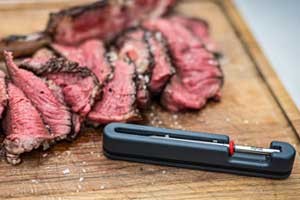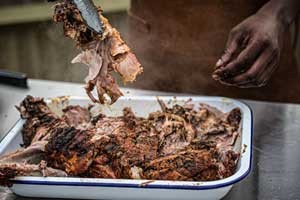Have you ever removed your meat from the heat at the perfect temperature, only to find it looks overdone once you...
The Ultimate Guide To Tempering Chocolate
Tempering chocolate can seem a little intimidating, so we asked James Parsons, experienced chocolatier and owner of SoSaSe Chocolat, to share everything he knows about creating beautifully tempered treats.
The very structure of what makes great chocolate so good is its sheen, snap and luxurious texture.
For anyone involved in chocolate or patisserie, accurate and fast reading thermometers are a must-have tool. The Thermapen One thermometer is the market leader for this requirement. With one second readings, unparalleled accuracy, and an auto-rotating display, it’s the thermometer of choice for chocolatiers and pastry chefs worldwide.
It’s crucial to be able to accurately read the temperature of the chocolate. Accuracy is everything, without accurate temperatures, I’d have no finished product. The Thermapen One has unparalleled accurate temperature measurement for this, the accuracy of the temperature will be the difference between the tempering process working or not.
There are three temperatures that you will need to use when tempering your chocolate. This depends on whether you are working with dark, milk or white chocolate. This recipe is for dark chocolate, but if you are working with milk or white chocolate you can simply alter the temperatures to the ones below.
Temperatures
Dark chocolate
First temperature: 45°C
Second temperature: 29°C
Third temperature: 31.5°C (or the working temperature indicated on your couverture chocolate packet)
Milk chocolate
First temperature: 45°C
Second temperature: 27°C
Third temperature: 30.5°C (or the working temperature indicated on your couverture chocolate packet)
White chocolate
First temperature: 45°C
Second temperature: 27°C
Third temperature: 30°C (or the working temperature indicated on your couverture chocolate packet)
Chocolate tempering glossary
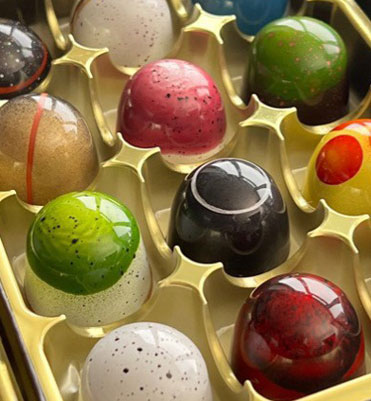
COUVERTURE - Chocolate that contains a higher percentage of cocoa butter (32-39%) than eating or baking chocolate.
BETA5 CRYSTALS - Also known as form V, this is when the cocoa butter crystals in the chocolate have been perfectly tempered to produce the optimum form (which is what gives the texture that desired snap).
SEED/SEEING METHOD - A method of tempering where small, chopped pieces of chocolate (known as the seed) are added to melted chocolate.
SILK - Tempered cocoa butter that can be used as a different method of tempering chocolate. This can be purchased in a paste or powdered form.
TEMPERING - The process of heating and cooling chocolate at controlled temperatures in order to create a glossy finish and good snap.
WORKING TEMPERATURE - The final temperature in the tempering process and the one that your chocolate should reach just before moulding into your finished design. A good brand of couverture chocolate will display this temperature on its packaging.
What is chocolate tempering?
Tempering sounds like a scientific process that only people who’ve studied for years can understand or achieve, it’s not! It is the point that the cocoa butter crystals in chocolate are lined up and in the correct form to get the best structural qualities of the finished chocolate.
What equipment do you need to temper chocolate?
- Couverture chocolate or silk (depending on which method you are using).
- A clean plastic bowl.
- A silicone spatula.
- Thermapen thermometer.
- A polycarbonate bonbon mould (if making chocolate spheres) – the ones I use are from Ecobaker.
Chocolate tempering tips
- Water will create so many problems in chocolate, take every step to avoid getting even the tiniest droplet of water near any melted chocolate.
- Any unused chocolate can be re-melted and tempered again, there is no waste with chocolate.
- Avoid melting your chocolate in glass or metal bowls. Glass retains the heat, and cooling is a crucial step in tempering chocolate.
- Avoid putting chocolate in the fridge, it attracts water and will be covered in condensation when you remove it from the cold.
- If you have tempered your chocolate correctly, it will stay stable at room temperature without any issues.
- Chocolate is prone to absorbing moisture from the air, it is best kept in an airtight container or zip lock bag.
Two methods for tempering chocolate
The seeding method for dark chocolate
You will need a good quality couverture chocolate. This can be purchased online. Look for one that has a high cocoa butter content (at least 35%) — don’t confuse the cocoa mass percentage with the cocoa butter percentage. I use this 70% dark chocolate from Henley Bridge.
You can warm your chocolate either in the microwave or by setting your bowl of chocolate over a pan of warm water to make a bain-marie.
There are three temperatures that you will need to use when tempering your chocolate. This depends on whether you are working with dark, milk or white chocolate. This recipe is for dark chocolate, but if you are working with milk or white chocolate you can simply alter the temperatures to the ones below.
Directions
- Take an amount of dark chocolate and remove approximately a third, keep this aside, this is the seed.
- Place the rest of the chocolate into a clean, dry, plastic bowl and warm to 45°C. To do this in the microwave, set it to 50% power and heat for 15 second intervals. Make sure you stir in between each interval, even if it looks like nothing is happening. Chocolate requires very gentle heating and you do not want it to burn.
- To heat over water, sit the bowl over a pan of 60°C water and melt slowly, stirring continuously. Make sure no water gets inside the bowl or this will ruin your chocolate.
- Use your Thermapen to test the temperature of the chocolate. When the chocolate reaches 45°C, remove it from the heat.
- Add a small number of pieces of the seed to the warmed chocolate. Stir with a spatula or using your Thermapen thermometer probe. This is one of the main reasons why Thermapen thermometers are used by chocolatiers; it’s not only incredibly accurate, but also sturdy enough to use as a tool for stirring viscous liquids whilst measuring at the same time.
- As you add more seed and continue to stir, the temperature will start to fall. You’ll see it change on the probe display. Continue to stir as well as adding small pieces of seed chocolate.
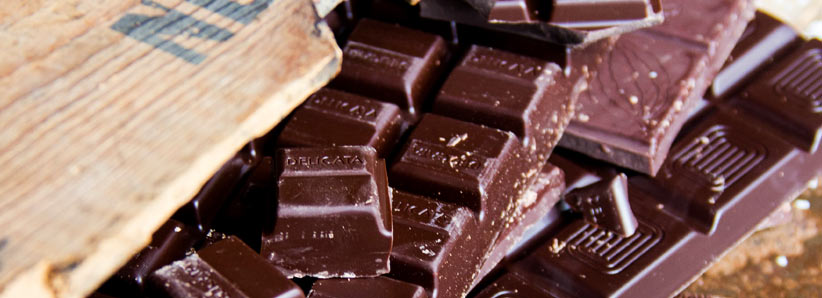
- As the temperature gets down towards 29°C, you’ll notice that the chocolate starts to thicken slightly, and the seed is taking a little longer to melt. You might not actually need all of the seeding chocolate. What is happening is that the seed chocolate, which contains beta5 crystals, is melting into the chocolate. As it cools and is stirred, it produces more new beta5 crystals.
- As soon as the probe reads 29°C you can scoop out any pieces of unmelted seed. Continue to stir to make sure the chocolate remains well mixed.
- Now you can start to warm it up to working temperature. This is best done with a hairdryer or low temperature heat gun. Warm the surface with the heating tool whilst continuing to stir. When it reaches 31.5°C the chocolate will be in temper and have the right amount of Beta5 crystals.
- You can test the temper of the chocolate by dipping a strip of greaseproof paper or a palette knife into the chocolate and leaving it for one minute. It should be tempered, have no white streaks and have a matt sheen to it. If you use a piece of paper, it will start to curl up at the edges — this is the chocolate retracting and the chains of Beta5 crystals tightening together.
- Now it is ready to use for dipping, shelling in a polycarbonate mould or pouring into a shaped mould. You can continue to warm it back up to 31.5°C or working temperature. Make sure you use the probe to get the exact reading.
Tempering with silk
Silk is a pre-crystalised cocoa butter that has been held at 33.8°C for an extended period and is loaded with the right crystals to temper chocolate. It comes in two forms: powder or paste. I like to use Mycryo®.
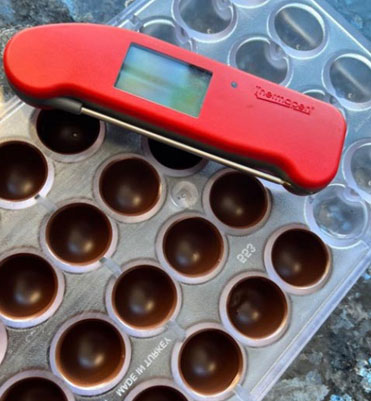
- Using powder or paste is significantly easier than seeding but requires greater accuracy and timing, which the Thermapen One is perfectly designed for. Because you are adding pure Beta5 crystals directly into the chocolate, reaching the high temperature is not a necessary step.
- Melt your amount of chosen chocolate to 34°C (you can use dark, milk or white chocolate for this method, as long as they contain a good percentage of cocoa butter), add 1% of the total weight in silk, either in the powder or paste form.
- Stir the silk through the chocolate using a clean spatula. Gently heat using a microwave or over a pan of simmering water, continuing to stir, until it reaches the working temperature indicated on the chocolate packet.
- Once it reaches working temperature, it is ready to use for whatever application you need.
"My Thermapen is my most reliable and trusted tool for all my chocolate work. I couldn't make or produce half the things I do without it. Precision of temperature is everything to me. Without my Thermapen I would be left guessing."








